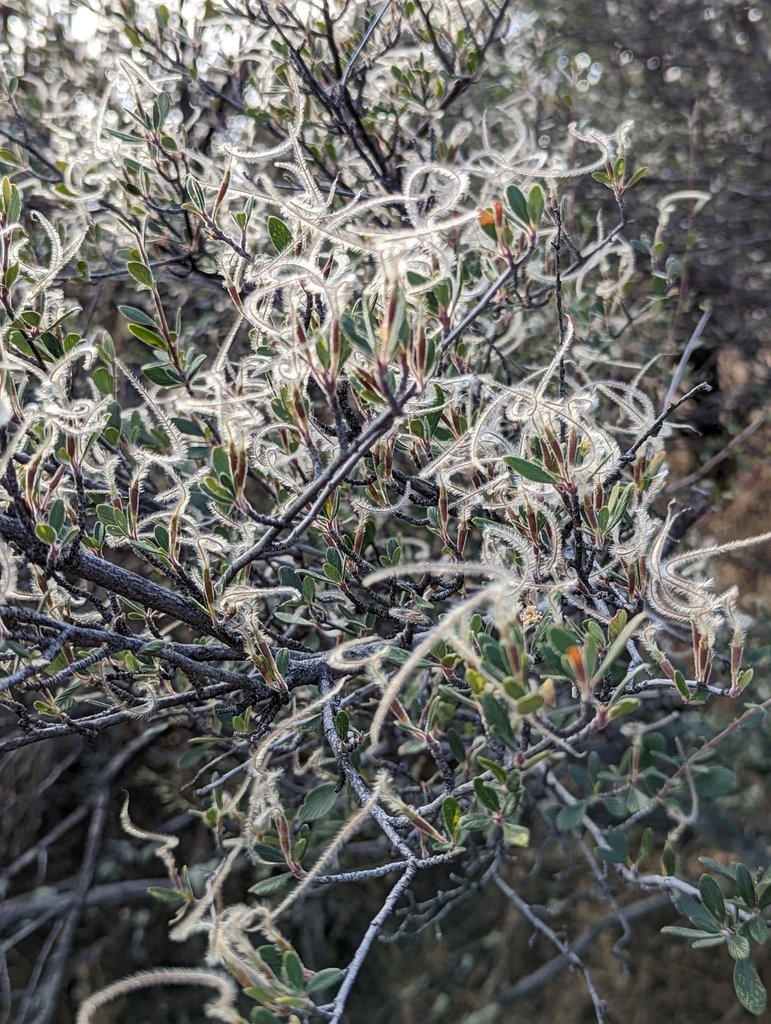The Genus Cercocarpus
Mountain Mahogany
Family: Rosaceae
This is a genus with 12 species native to the western United States and northern Mexico, where they grow in chaparral and semidesert habitats and climates, often at high altitudes. Several are found in the California chaparral and woodlands ecoregion.
Members of the genus are deciduous shrubs or small trees, typically reaching heights of 8–18 ft. tall, but exceptionally up to 40 ft. high (not in the low desert though). In the wild, lots of plants will only be about 3’ tall because deer will browse the plants—plants that are more inaccessible, like out of cliffsides, will reach taller dimensions.
Nectar-rich flowers attracting many pollinators. Larval host plants for many butterfly species including the western sheepmoth (Hemileuca eglanterina) and the mountain mountain mahogany hairstreak (Satyrium tetra) as well as several species of moths.
The hard, heavy wood is an important source of fuel in local mining operations; it is also used for novelties, as it takes a high polish. The name Mountain-mahogany applied to this genus is misleading; these shrubby trees are not related to true mahogany (Swietenia), a valuable cabinetwood of tropical America. The dark reddish-brown, mahogany-colored heartwood may have led to this name. Navajo Indians made a red dye from the roots by grinding and then mixing them with juniper ashes and powdered alder bark.
The name is derived from the Greek words kerkos, meaning "tail" and karpos, meaning "fruit". It refers to the tail-like plume on the fruits.
Plants will usually be very upright-growing in the low desert since deer aren’t common (wild plants get browsed back).
Plant in full to part sun, avoid too much reflective heat. Moderate water with good drainage. These plants are very cold hardy and there is no need to worry about the cold in most of our low desert or even mid elevation locations. There is almost virtually no care differences between the species.
Cercocarpus breviflorus grows in the mountains of the southwestern United States and northern Mexico, often at moderately high elevations. It can be found in Arizona, New Mexico, and Texas, as well as from Sonora to Tamaulipas in Mexico, and as far south as Querétaro. Photo by Patrick Alexander, SEINET
Cercocarpus intricatus is native to dry habitats, such as deserts, mountain slopes, plateaus, and woodlands, from California to Colorado. It's primarily found in Utah, Arizona, and Nevada at elevations of 4,000–9,000 ft.Photo by once-ler on iNaturalist
Cercocarpus ledifolius is found on dry, rocky slopes, pioñon juniper woodlands, ponderosa pine forests from 5,000-9,500 ft in the western half of Arizona and a few populations in adjacent Mexico. Photo by James Bailey on iNaturalist
Cercocarpus montanus is found on dry slopes and along washes from 1,000-7,000 ft. in most of western US: Texas north to Montana and Idaho, south to California and continuing into to central Mexico. Photo by Carol Jacobs-Carre, iNaturalist





